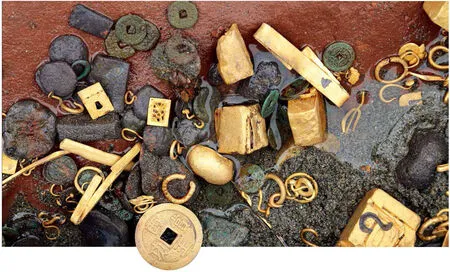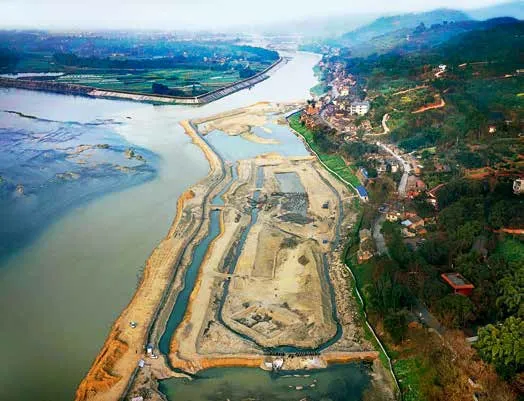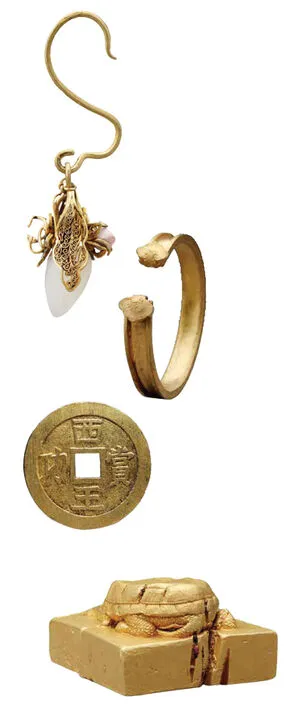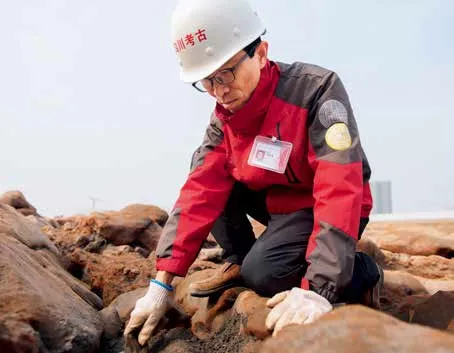A River of Archaeology
Text by Zhou Xin
Photos courtesy of Sichuan Provincial Cultural Relics and Archaeology Research Institute
“The fruits of archaeology are not private property held by archaeological institutes or a handful of archaeologists,but a legacy shared by all of society.”

Relics recovered from the Jiangkou ancient battlefield site.
December 2016 to present
The riverbed of the Minjiang River in Meishan City,Sichuan Province
Late Ming Dynasty
One million square meters
Rated as one of China’s top 10 new archaeological discoveries in 2017;
Listed as one of China’s 100 great archaeological discoveries in the past 100 years in 2021
The Minjiang River runs through Sichuan Province in southwestern China.It is an important tributary of the upper reaches of the Yangtze River.At the bottom of the Minjiang River lies a huge“treasure” along with an important part of history.
According to historical records,Zhang Xianzhong (1606-1647),the leader of a Chinese peasants uprising in the late Ming Dynasty(1368-1644),once established a kingdom in Sichuan.When Zhang’s army was defeated,the treasure they had accumulated all sank to the bottom of the Minjiang River along with their boats.The treasure has been hidden at the bottom of the river for hundreds of years.
In December 2016,the first archaeological excavation in search of the underwater treasure was carried out.Liu Zhiyan,director of the Underwater Archaeology Center of the Sichuan Provincial Cultural Relics and Archaeology Research Institute,headed the archaeological excavation team.He led the team through several rounds of excavations with the help of cofferdam.Tens of thousands of cultural relics have been found,and excavation work is still ongoing.
Echoes of History
How are cultural relics excavated from the bottom of a river?
“Shipwreck archaeology usually involves diving to salvage or explore,which was not suitable for excavating the sunken relics at the bottom of the Minjiang River,” Liu Zhiyan said.The water of the Minjiang River is turbulent,preventing underwater archaeological work.Moreover,the cultural relics at the site were no longer in a boat,but scattered by the water.It was not realistic to dive down to find each piece individually.
“We later came up with the idea of building a cofferdam in the river to bring the archaeology work up to the land,” Liu recalled.
The water level of the Minjiang River varies greatly between dry season and flood season.The dry season occurs in winter,when the water level is about two to three meters.In summer,however,the river’s water level reaches six to seven meters.Therefore,the archaeological team usually works on the site in winter.The width of the cofferdam is about 150 to 200 meters,accounting for about half of the width of the river surface during the dry season.“The cofferdams are all temporary and dismantled every year after the archaeological tasks during the dry season are completed,” he explained.Since 2016,the archaeological team has conducted five excavations of over 20,000 square meters.The total area of the site is about one million square meters.
In the last years of the Ming Dynasty,frequent natural disasters and political corruption left many people destitute.Peasant revolts broke out in various places.In 1644,Zhang Xianzhong proclaimed himself emperor in Chengdu,Sichuan Province,and established the Daxi Kingdom (or Great Western Empire).Before that,his army fought in several provinces,amassing considerable treasure.

A bird’s-eye view of the cofferdam for archaeological work at the Jiangkou ancient battlefield site.

Relics excavated from the Jiangkou ancient battlefield site.From top to bottom are an earring,a bracelet,a coin engraved with characters meaning “Rewards from the King of the Great Western Empire,” and a gold stamp of the King of Shu in the Ming Dynasty.
Thousands of cultural relics excavated are directly related to Zhang Xianzhong’s kingdom,including some silver ingots and gold and silver coins.Liu Zhiyan said that the excavation has provided bright illumination on several points:The cultural relics unearthed are rich in diversity,with hierarchies ranging from high to low—from royal supplies to civilian objects.The cultural relics reflect the politics,economics,military,culture,and other aspects of Ming Dynasty society.“Many were captured by Zhang Xianzhong from various places,so the cultural relics are not only related to Zhang Xianzhong,but mirror different levels of Ming Dynasty society,making them unmatched by any previously discovered ruins of the same historical period.”
Sowing Seeds of Archaeology
On Weibo,a Chinese social media platform similar to Twitter,Liu Zhiyan is better known by the handle “Kaogujun,” meaning“archaeologist.” He has grown a massive amount of followers on Weibo that has surpassed three million.The majority of his followers are people interested in archaeology and traditional culture.They want to learn from his posts.His posts provide information about archaeological practices and interesting cultural relics,and a quick resjponse to all the curious followers.
“What is archaeology used for?”asked one follower.Liu believes its key aims include:supplement history,protect cultural relics,and promote culture.
In addition to online teaching,Liu also lectures at schools all over the country every year to popularize archaeological knowledge.He uses language that students of different ages can understand.He delivers intricate research results to college students and simple but vivid explanations to primary and middle school students.“Taking the silver ingots for example,” he illustrated.“I will tell elementary school students how much these silver ingots can buy today,but I shall explain to college students about the source of silver and the elements in the silver ingots.”
“Not every child will be interested in archaeology,but if 100 in 1,000 are interested,of whom 10 choose this major in college,that’s a big success.”
Liu’s tireless popularization efforts have paid off.A high school student once sent him a private message on Weibo to announce that he chose to major in archaeology in college.A postgraduate science student switched focus to archaeology after listening to his lectures and was admitted to a Ph.D.program in archaeology.
Liu also recruits volunteers to help with the excavation.He is involved in establishing a virtual archaeological experience program at the Sichuan Provincial Cultural Relics and Archaeology Research Institute.
“I want to show the public that the fruits of archaeology are not private property for archaeological institutes or a handful of archaeologists,but shared by all of society.”
Through these measures,Liu Zhiyan wishes the public understand and support archaeology,so that more and more people can better understand and carry forward China’s history,culture,and tradition.

Liu Zhiyan works at the Jiangkou ancient battlefield site.After excavation work during the day,it is necessary to sort out and record relevant data,so he often works until midnight.
China Pictorial2022年7期
- China Pictorial的其它文章
- Nanhai No.1:Leading China’s Underwater Archaeology
- Tongmuling Site:An Archaeological Breakthrough in China’s Mining and Metallurgy
- Lost Fortress to World Heritage
- The Housi’ao Kiln Site:Exemplary Ceramic Archaeology
- Liangzhu:A Model for Large-Scale Archaeological Sites
- A Discovery for the Ages
